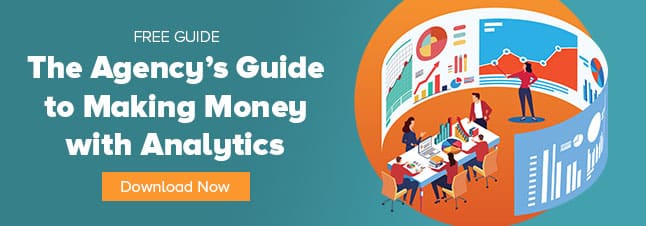
Why do agencies need a marketing analytics strategy? Because it’s one of the best ways to start, maintain and expand profitable relationships with clients.
That’s especially true right now, when more brands are in-housing work that once went to agencies. According to Gartner’s CMO Spend Survey for 2019-20, brands reduced spending on agency contracts to 22 percent of their budget last year, down from 23 percent the year prior, and 24 percent the year before that. From Gartner:
Agency spending is shifting away from commoditized activities like media planning and buying, and toward strategic activities such as strategy development and digital transformation program execution. This is where agencies want to play, because they can charge more for value-added activities and the contracts are longer-term.

By developing the ability to produce valuable, one-of-a-kind insights and in-depth reporting, agencies protect their competitive position in three specific ways:
1. Marketing analytics improves client retention
Clients expect to receive regular updates about their campaigns’ progress, and monthly or quarterly reports aren’t enough anymore. Daily reporting is increasingly becoming table stakes for the client-agency relationship.
If you’re an agency, you should embrace rapid reporting because it increases your value in the eyes of clients. Next-day reporting gives you the power to quickly recalibrate strategy if a campaign is underperforming, or to double-down when you hit on a winning idea. You can’t do that if your reports aren’t ready until after the campaign is completely wrapped up.
The trick, of course, is actually producing reports faster. Building reports can be very time-consuming if you’re manually downloading data from Facebook, Google Analytics, et al. and putting the results into Excel or Google Sheets. If you’re just getting started with analytics, we recommend investing in reporting automation so you can share reports in the form of regularly updated marketing dashboards.
2. Marketing analytics enables client growth
Analytics can make your relationship with clients “stickier” and improve the odds that you’ll be awarded more work from your existing clients.
For example, when you increase the speed and value of your reporting, you give your clients proof that your team is capable of more than mashing spreadsheets together. “Could you include our sales and lead numbers in our reports?” They might even ask you to analyze channels that your agency isn’t directly responsible for, like PR or social media.
Not that you have to wait for clients to ask for help. Several Alight clients have grown their analytics programs (and their bottom lines) by creating a tier of analytics “products.”
These are simply different sets of deliverables, usually in the form of a dashboard or suite of dashboards, that offer different levels of insight at different price points. Tier 1 might be a basic report on paid media, while Tier 3 focuses on predictive analytics — for example, a calculator that lets clients forecast how much new business they can expect at different levels of ad spend.
A tiered approach allows you to meet each client where they are, with the budget and challenges they currently have, while leaving the door open to upsells as the client’s interest and capacity grow. This ebook shares strategies for creating a monetization strategy around analytics products.
3. Marketing analytics can help you win new clients
When you have a marketing analytics strategy, especially one that’s capable of producing sophisticated insights and recommendations, you instantly differentiate your agency from competitors who don’t. And there is a vast universe of agencies who are still sleeping on the importance of marketing analytics as a service line.
We’ve worked with several agencies who’ve built marketing analytics teams and then leveraged that expertise as a key selling point when pursuing new business. Infinity Marketing, a full-service agency in Greenville, S.C., is a textbook example. They now treat analytics as a core offering, next to creative, media and web services. (This case study explains how Infinity built its program.)
Some agencies are hesitant to launch a marketing analytics unit because of the staffing and technology required. It’s true: If you want to generate revenue with analytics, you’re going to need to invest resources in that effort.
But there are ways to reduce the cost burden of starting up an offering, either with marketing analytics software or service providers who shoulder part of your team’s load, allowing you to do more with fewer full-time employees. Alight’s Agency Analytics solution is a good example of this approach. It gives agencies everything they need to produce reporting and insights, including our ChannelMix platform, marketing dashboards, strategy, services and other support.
Remember: Marketing analytics should be a strategy
One final piece of advice: If you do decide to invest in marketing analytics, remember to treat it as an integral part of your business strategy, something that you consistently invest in, promote and consult when making business decisions.
For a lot of agencies, the temptation is to buy marketing analytics software, tell the most junior analyst to start building dashboards and call it good.
But marketing analytics is capable of much more than that. Take it seriously, and it could become one of your agency’s most valuable, most durable areas of expertise.
Try Alight’s Solution for Agency Analytics and Reporting
Alight’s suite of next-generation analytics solutions delivers everything that agencies need to build efficient, scalable reporting and insights. Request your free solution evaluation today!
